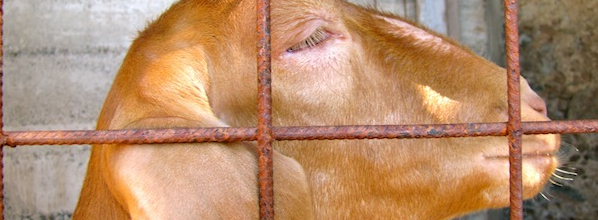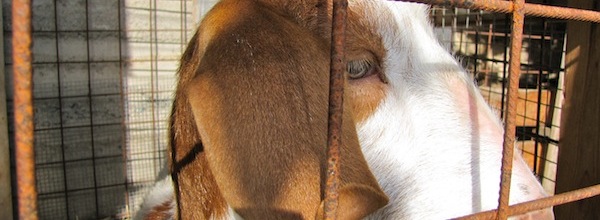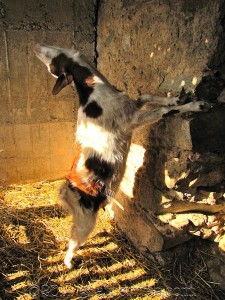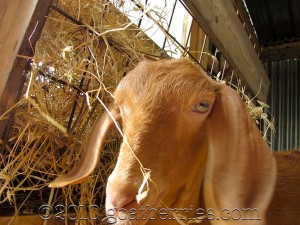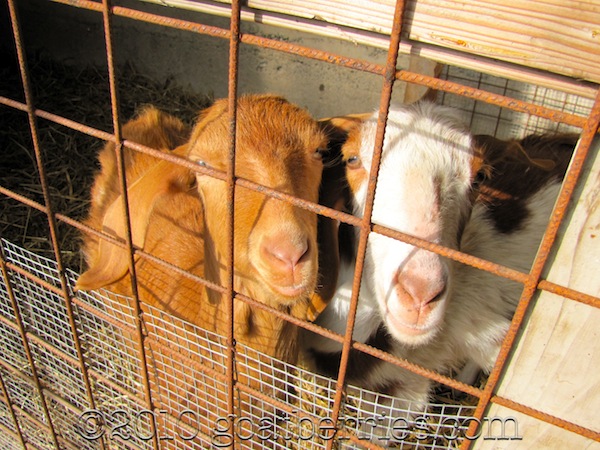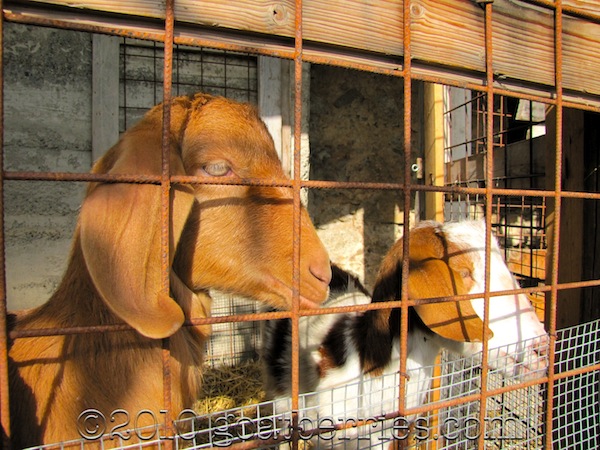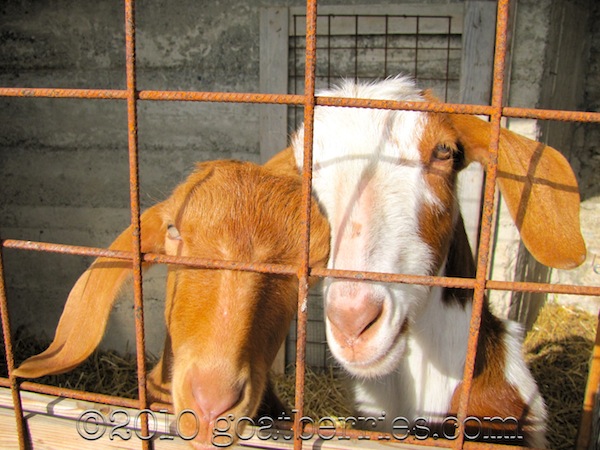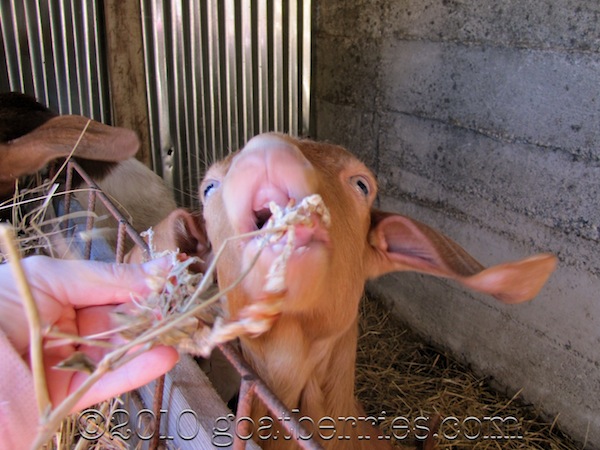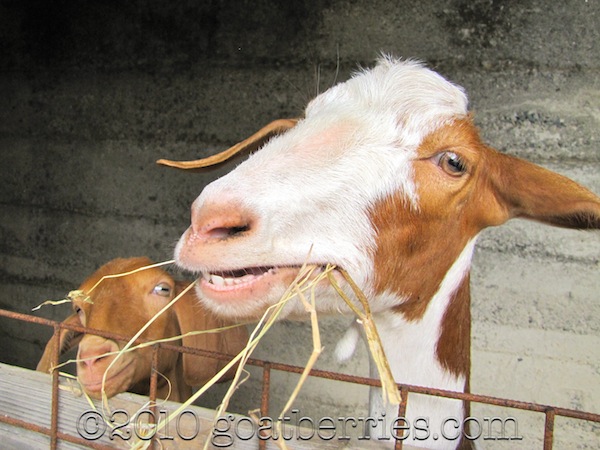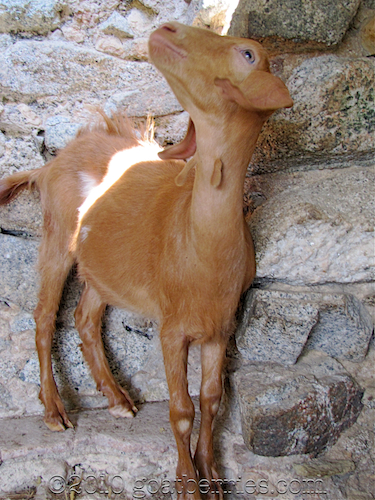Archive for the ‘Goat Health’ Category
Goat Eye Injury: Here’s Hay in Your Eye!
What to do when your goat gets a piece of hay stuck in her eye.
Read on...How to Tell if Your Goat Is in Heat
If you have a doe that’s eight months old or older and it’s, say, October to January and you’re in the Northern Hemisphere, your crying goat just may be looking for a little love.
Read on...Why Is My Goat Crying and Restless?
I got a question from a reader recently asking what might be wrong with a goat that is crying and restless. Great timing, in fact, because I myself have a goat who is crying and restless — Signorina Pasqualina.
We’ll get back to her in the next post (stay tuned!), but first, and I can’t stress this enough, it is extremely important that you know your goat when trying to diagnose what the problem might be. That is, you need to know your goat’s normal behavior in order to tell if something is off — and not all goats act the same in normal circumstances, so it can be difficult to generalize. My overriding rule is that if you feel something is off, it probably is, so pay attention. But what are you looking for?
What Kind of Crying Is It?
First of all, ask yourself: what kind of cry is it? If you know your goat, you know what s/he sounds like most of the time — and you’ll definitely know the difference between normal “Hey maaaa I’m here!” bleating and any kind of pain or distress. Quick example: when Pasqualina was just a wee kid, she got herself tangled in a cord and believe-you-me, even from a pretty good distance, I knew that bleat was not just for fun and games; she was terrified (although not injured, thank goodness).
One important question to ask at this stage is whether your goat has a buddy. It doesn’t have to be another goat necessarily, but goats are social animals, and they like company. So your goat may just be crying because it’s lonely and wants some attention. But if your goat has company and suddenly starts crying for no reason, read on.
Reasons Why a Goat Might Be Crying
Once you’re pretty sure there’s something else behind the cry other than just trying to get your attention, you should look for other symptoms or behaviors that aren’t normal for your goat so you can narrow down what might be wrong with him or her. Goat bloat is where my mind always turns when I think of goat health problems, so let’s go there first.
Symptoms of Goat Bloat
Other than crying in pain, the telltale symptom of goat bloat is a larger than usual (and larger than the other side), distended left side of the goat, where the rumen is located. Goats with bloat may also show other signs of being uncomfortable like teeth grinding, kicking at their sides, and just seeming generally depressed. You should put your ear up close to the rumen and check for gurgling sounds — there should be some if the rumen is working correctly. If the bloat is more severe, a goat may also have trouble breathing.
I’ll be writing more about goat bloat and other goat illnesses in the future for handy reference, but for now, know that if you think you goat has bloat, you should first check and make sure there are no obstructions in the mouth or throat; generally you can just run your hands down the throat and feel for anything out of place. You can then start massaging his or her sides to kind of loosen up the gas that’s in there, focusing on the upper left, kind of like you’re burping a baby — your goat will hopefully start making some burps, etc. and release some gas. If some air has escaped, you can then offer some baking soda to further help balance that pH in there.
For lots more detailed information on goat bloat, visit Fias Co Farm.
There are many other illnesses a goat could have, though, so be sure to check any and all symptoms before just deciding your goat is wanting attention. Here is a handy list of potential goat illnesses along with their symptoms at from GoatWorld.
One thing we haven’t touched on, though, as a reason your doe might be crying is that she’s in heat — which is exactly what we’re going to talk about next time using our Pasqualina as a case study.
A Fall Without Goat Breeding
Faithful followers of Pasqualina may remember that by this time last year, she was already pregnant with (who we now know as) Pinta.
This year Pasqualina is decidedly without kid — by our choice. And it really has more to do with Pinta than Pasqualina.
I like to call the general rule for mating a female goat as “8 and 80.” That is, when she reaches eight months old and 80 pounds, she can be safely bred.
Pinta turned eight months old toward the end of November, which technically is still heat season, but I really don’t think she was up to 80 pounds. We didn’t weigh her, so I could be wrong, but she just *seems* quite a bit smaller than Pasqualina was when we bred her (Pasqualina was around nine months old). In any event, we just feel more comfortable waiting to breed her, so that’s what we’re going to do.
We could have just bred Pasqualina, but that would have meant putting a (borrowed) buck in with Pasqualina and locking Pinta in another pen by herself to avoid any “accidents” with the buck. Yes, the pens are only separated by a see-through gate, but we figured not only would that be sad for Pinta, it would also be a little easier on us to have them both bred at the same time rather than staggered.
So the next breeding season will come early next summer, and the kids should arrive in November if, as we hope, all goes well. I’m already a little nervous about the weather being chilly for their delivery, although truth be told, daytime temps around here in November are usually still in the 70s — but there’s nothing like being a worrywart goat maaaa, right?
Anyway, for now, we just have our two girls, and they seem OK with that, don’t you think?
Raising Goats from the Teeth Up
People who aren’t familiar with goats are sometimes afraid they’re going to bite them, which is a rather baseless fear not only because goats are generally some of the least aggressive animals around (headbutting aside) but also because they have no top front teeth.
See those gorgeous gums? That’s all they have up there — just a dental pad.
They do have bottom teeth in the front, however.
When a goat is full grown, he or she will have eight incisors (biting or cutting teeth), all permanent teeth. Just like humans, though, they start out with baby teeth, so to speak. A kid has all small, sharp teeth for about a year. When the kid is about a year old, the center two teeth go bye-bye and are replaced by two permanent teeth. Then about every year or so after that, two teeth moving away from the center teeth on either side are replaced with permanent teeth until the goat has all eight permanent incisors by about four or five years old.
At that point, the teeth start to space apart, and you can begin to tell the age of the goat by the wear and tear on the teeth as opposed to the number of permanent versus baby teeth.
So does all this mean you can’t really be harmed by a goat’s teeth? Not exactly.
They *do* have 24 molars for chewing their cud in the back of their mouths — six on each side, upper and lower. And they are sharp as all get out, so you don’t want to be sticking your fingers toward the back of a goat’s mouth.
In other words, although it’s quite cute to see and feel the lil’ baby goats gnawing on the tip of your finger between their incisors and dental pad, once they start shifting that head to get your finger to the back of their mouth, you *must* get out of there, lest you become the cud.
Just trust me on that one, mkay?
More Goat Questions Answered!
It’s time again to talk about some of the searches that have brought people to Goat Berries. Read previous entries at Answering Goat Questions: Part I and Part II.
As I mentioned before, goats and watermelons have been on a lot of goatie friends’ minds these days, but here’s what else they’ve been wondering about:
1. Goats fig leaves edible : I’m assuming this is asking whether goats can eat fig leaves. Mine have, although we were told by a an experienced goat herder here that they shouldn’t have too much, so we tend to give them to our girlies just when we’re pruning the fig trees a bit — they never get more than a few branches at a time, and that’s usually weeks or months apart.
2. Goats and pit fruit / can goats eat fruit with seeds/pits : They sure can, and many times they’ll just spit the pit out if they don’t want it. Pasqualina has spit out both apricot and plum pits. It’s *so* fun to watch them eat these as they roll them around in their mouths. That said, don’t give them too many at a time — just like our digestive systems don’t love too much of a good thing like apricots and plums, neither do theirs.
3. Can goats eat banana peelings? : Whoo boy, can they — and my girl Pasqualina *loves* them. Loves bananas too. The other does we had also loved both fruit and peel, but Pinta isn’t old enough to care yet, apparently. Again, though, everything in moderation!
4. Kid goat cries all the time / why does my goat cry : Dig if you will the pic-ture. Oh wait, that’s When Doves Cry. Anyway, this is a tough one and requires that you know your kid pretty well. Some kids are just loud and cry when they want attention or food or milk or all of the above. Generally it’s not a problem unless it sounds like the kid’s in pain.
Of course, my kid cries like she’s in pain when she’s bored, so even that’s not a reliable measure. Who her?
In short, I think the answer to the question is most likely the age-old one: because s/he can. But if the crying seems abnormal to you, do look for other signs of illness such as lack of appetite, bloating, and just otherwise not doing goat-like things.
5. Milky sticky discharge coming out of nanny goat before kidding : Gross, but totally normal. We noticed it on two of ours about 24 hours before kidding. The other one didn’t show anything, or maybe we just weren’t looking (she was the first to go). I actually have a photo of this, but I think you get the idea; if you want to see it though, please feel free to contact me. In any event, you’ll be having a kid or more *very* soon. Congratulations!
Remember if you have any goat questions that aren’t answered somewhere in the blog, don’t be afraid to ask! I can’t promise to know the answer, but I will be happy to put it out there to other goatie lovers if I don’t.
And please feel free to add your bleats of wisdom on the above questions as well!
Buon weekend!

